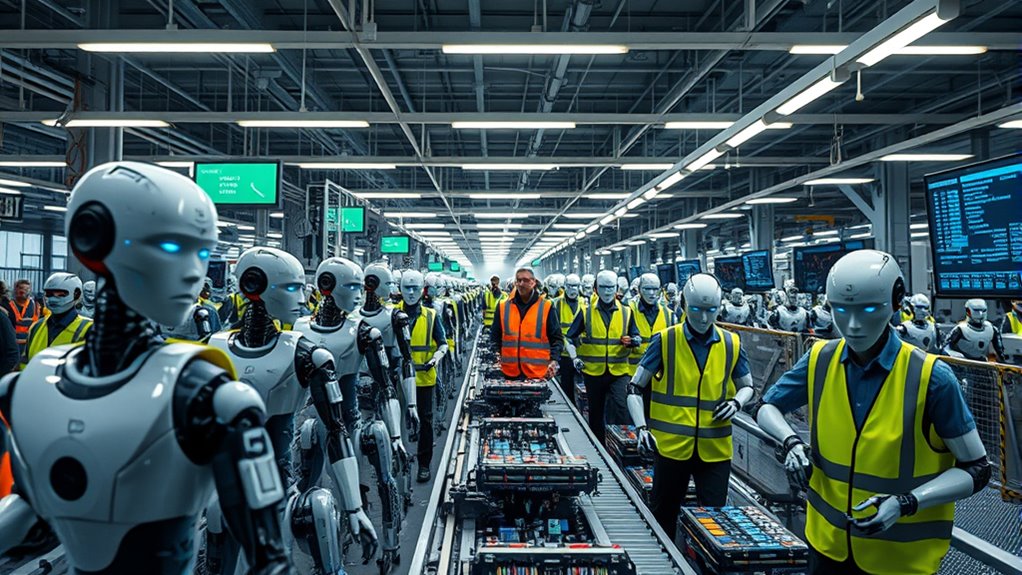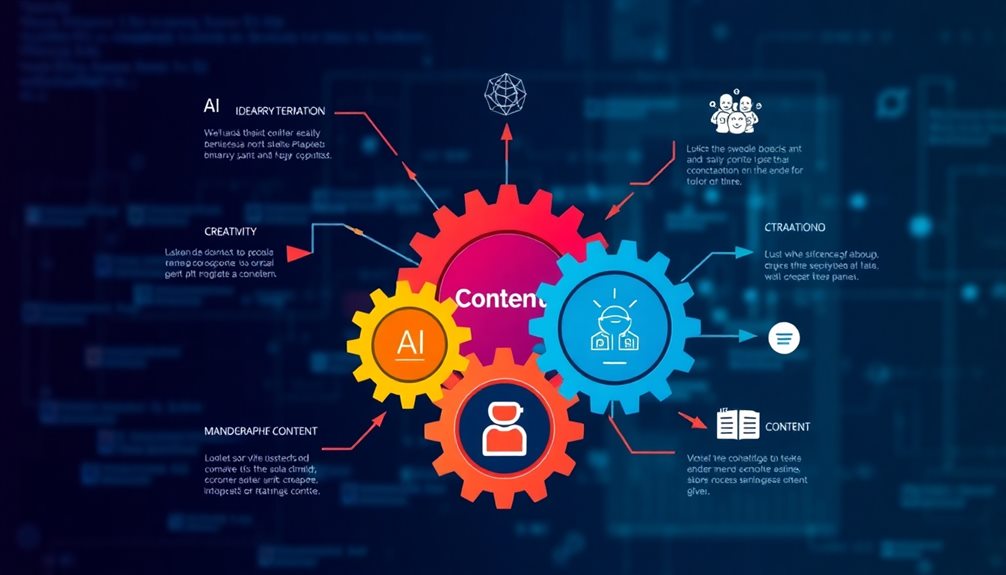AI’s rapid adoption worldwide means job security is changing fast. While millions of roles may disappear, new opportunities are emerging in oversight, data management, and human-AI collaboration. Many sectors will see shifts in roles, with some tasks fully automated and others reshaped. Staying adaptable and reskilling can help you navigate this transformation. To understand how to protect your future in this evolving landscape, explore the detailed trends shaping this labor surge.
Key Takeaways
- AI adoption threatens millions of jobs globally, especially in data-rich industries, risking significant job displacement.
- Despite job cuts, AI is expected to create 78 million new roles, shifting employment toward oversight and human-AI collaboration.
- Job security varies by industry; data-rich sectors face higher disruption, while blue-collar roles are less affected.
- Rapid AI-driven productivity gains may increase inequality without reskilling, challenging long-term job stability.
- Continuous reskilling and adaptability are essential for workers to maintain job security amid AI-driven labor shifts.

As AI adoption accelerates worldwide, millions of jobs are at risk of displacement, fundamentally reshaping job security across industries. Nearly 90% of US companies have integrated AI into their operations, with about 30% replacing workers with AI tools like ChatGPT. This rapid shift suggests that, by 2030, up to 92 million roles could vanish, though the same reports predict a net gain of 78 million new jobs. If widely adopted, AI could displace around 6-7% of the US workforce, impacting sectors rich in data and automation. You might see some tasks fully automated—about 40% of companies are automating routine work—while others are using AI to augment human roles. The impact varies considerably depending on the industry. Data-rich sectors experience swift changes, with jobs being disrupted and created at a rapid pace, whereas data-poor industries face more resistance to digital transformation. AI-driven job displacement is expected to affect hundreds of millions globally. AI’s influence on labor productivity is profound. Fully adopted generative AI is expected to boost productivity by roughly 15%, but this can lead to short-term increases in unemployment—about 0.3 percentage points for every 1% growth in productivity. Usually, these disruptions are temporary, resolving within about two years, but they still cause concern. In sectors where AI is highly applicable, many roles may shift or restructure rather than disappear outright, demanding new skills and capabilities. This transformation may deepen economic inequality unless reskilling efforts keep pace. The overall impact isn’t uniform; some industries and roles will be hit harder than others. Certain occupations face higher AI exposure, especially in computer and mathematical fields, where unemployment may rise more substantially. The rapid pace of technology change can make it challenging for workers to keep up. Conversely, blue-collar jobs are less affected, although public anxiety often inflates perceived displacement rates. As AI reshapes the job landscape, new opportunities are emerging—roles in oversight, data quality, and human-AI collaboration are growing, often requiring advanced technical skills. Workers who develop these skills can command wages about 56% higher than their peers. While AI’s evolution resembles historical technological shifts, its rapid pace demands that you stay adaptable—those who reskill and embrace new roles will be better positioned to thrive amid this labor surge.
Frequently Asked Questions
How Will AI Impact Job Creation in Developing Countries?
AI can create new job opportunities in developing countries by boosting productivity and enabling industries to expand. You might see more cognitive jobs and improved service sectors, especially if policies support workforce training and digital infrastructure. However, you should also be aware of displacement risks, particularly for routine tasks. To benefit fully, you need to advocate for adaptive education and strategic investments that promote inclusive growth and take advantage of AI’s potential.
What Policies Can Governments Implement to Protect Workers?
You can protect workers by implementing policies like rapid retraining programs, which help 78% of displaced workers find new roles quickly. Prioritize AI skills education in schools, ensuring workers are prepared for future jobs. Develop workforce agility, build talent pipelines, and offer incentives for companies creating jobs in less-affected sectors. Strengthen social safety nets and worker protections, so everyone has support during shifts and can adapt to the evolving job landscape.
Will AI Lead to Increased Income Inequality Globally?
Yes, AI can increase global income inequality if high-income regions adopt it faster, leaving low-income economies behind. You might find that automation replaces many low-skilled jobs, widening the gap between the wealthy and the disadvantaged. However, with targeted policies like skills training and infrastructure investment, you can help guarantee AI benefits everyone equally, reducing disparities and fostering a more balanced economic growth worldwide.
How Quickly Can Industries Adapt to Ai-Driven Changes?
Think of industries as early internet adopters in the 1990s—they can adapt quickly if they embrace change. You’ll find sectors like information technology already racing ahead, with many firms doubling AI use in just two years. By investing in new skills and process redesign, industries could fully integrate AI within a few years, drastically boosting efficiency and reducing costs. Staying agile now guarantees you don’t get left behind in this rapid transformation.
What Skills Will Be Most Valuable in an Ai-Dominated Workforce?
In an AI-dominated workforce, your most valuable skills will be a mix of technical and soft skills. Focus on building expertise in AI, data analysis, and cybersecurity, while also honing soft skills like empathy, creativity, and critical thinking. Stay adaptable through lifelong learning, and develop hybrid skills that combine technical knowledge with judgment. Your ability to collaborate with AI tools and lead change will set you apart in the evolving job landscape.
Conclusion
So, as AI’s job surge takes over, you might find yourself marveling at how technology promises security but ends up rewriting the rules entirely. Ironically, the more AI advances, the more you realize your job isn’t as safe as you thought. Instead of comforting certainty, you’re left questioning what’s next. In this new era, it seems your job security is less about stability and more about riding the unpredictable wave of innovation—good luck!










